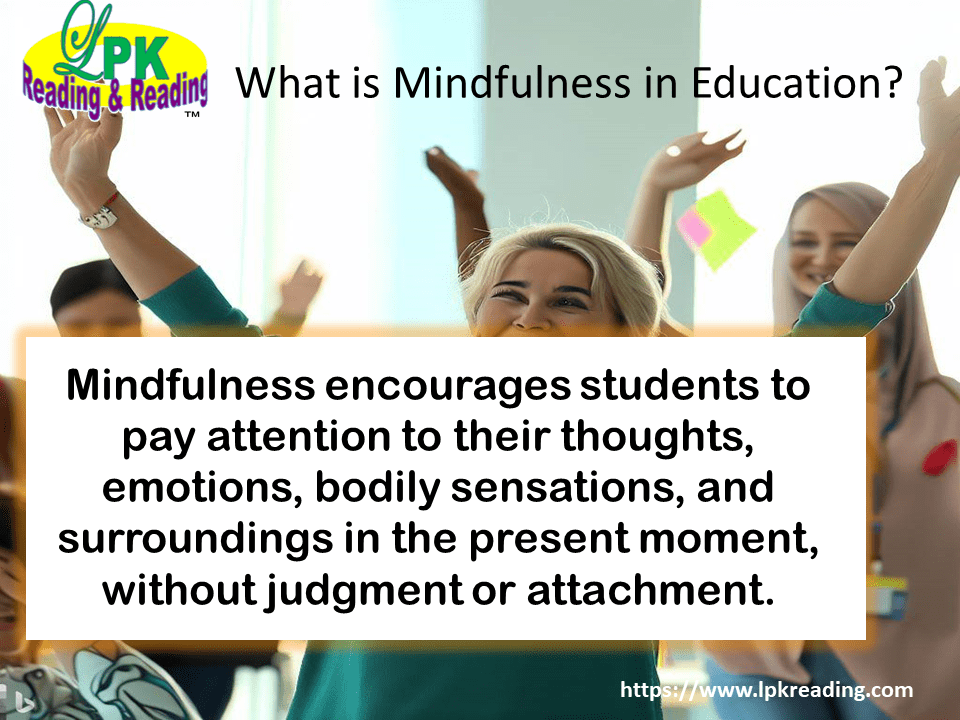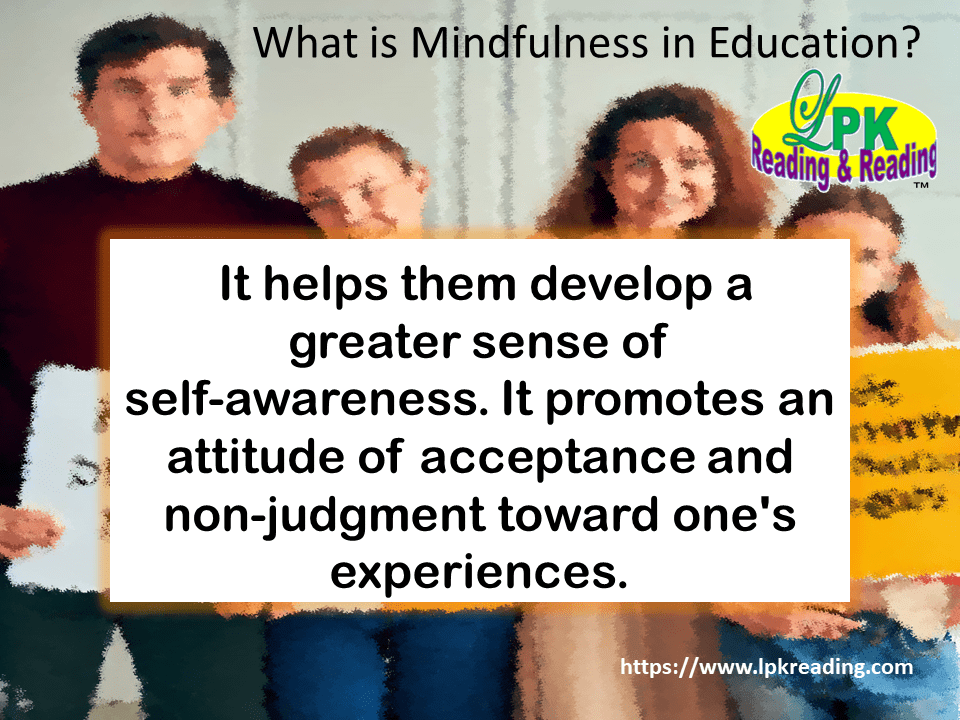Collaboration between parents and teachers is crucial for the holistic development and success of children. As a teacher, while having a conversation; have you ever came across an aggressive parent? Or a teacher who has been overwhelmed by everything that is around them that you
look at them and you actually just want to get up and leave? By incorporating mindfulness methods into their approaches, parents and teachers can establish a strong partnership that promotes the well-being and academic progress of the child.
What is Mindfulness in Education?
Mindfulness in Education refers to theintentional cultivation of present-moment awareness and non-judgmental attention in the educational setting. It involves incorporating mindfulness
practices and principles into the classroom to enhance students' well-being, emotional regulation, and learning abilities.
Mindfulness encourages students to payattention to their thoughts, emotions, bodily sensations, and surroundings in the present moment, without judgment or attachment. It helps them develop a greater sense of self-awareness. It promotes an attitude of acceptance and non-judgment
toward one's experiences. Students learn to observe their thoughts and feelings without labeling them as good or bad, right or wrong, fostering a compassionate and open-minded approach.
Students are equipped with tools to bettermanage their emotions. By cultivating awareness of their internal states, they can recognize and respond to their emotions in a skillful manner, rather than reacting impulsively. Mindfulness practices, such as deep breathing, body scans, and guided meditations, can help students reduce stress and anxiety. Regular mindfulness exercises create a sense of calm and relaxation, improving overall well-being.
These mindfulness exercises train studentsto direct their attention to the present moment, enhancing their ability to concentrate and stay focused. This can positively impact their academic
performance and learning outcomes. It encourages students to develop empathy and compassion for themselves and others. It fosters a sense of interconnectedness and understanding, promoting positive relationships and a supportive classroom environment.
Mindfulness can be integrated into varioussubjects and activities within the curriculum. For example, it can be incorporated into mindful breathing exercises during transition times, mindful
listening during discussions, or mindful movement during physical education.
How can Parents and Teachers Appreciate Mindfulness
Everyone face challenges daily and it isimportant for an individual to know how to take charge of their emotions, strengths and weakness. The teacher/parent relationship is of crucial importance for student holistic wellbeing.
Here are some detailed and formal tips forparents and teachers to enhance their collaboration and integrate mindfulness in education:
1. Establish Open and Regular Communication:
- Schedule regular meetings orcheck-ins to discuss the child's progress, challenges, and achievements.
- Practice active listening andshow empathy towards each other's perspectives and concerns.
- Share information about thechild's behavior, emotions, and learning experiences to gain a holistic understanding.
2. Set Shared Goals:
- Collaboratively identify andprioritize goals for the child's education and development.
- Ensure that goals are specific,measurable, achievable, relevant, and time-bound (SMART).
- Consider the child's individualneeds, strengths, and challenges when setting goals.
3. Share Strategies and Resources:
- Exchange effective strategiesand resources that can be used at home and in the classroom.
- Provide parents witheducational materials, recommended books, and online resources to support learning.
- Share mindfulness techniquesthat can be incorporated into daily routines to promote calmness and focus.
4. Promote Consistency:
- Discuss and align on routines,expectations, and behavior management strategies.
- Ensure consistency in rules andboundaries between home and school to provide a structured environment for the child.
- Share information about anychanges or disruptions that may impact the child's behavior or learning.
5. Encourage Active Involvement:
- Invite parents to participatein school activities, parent-teacher associations, or volunteer opportunities.
- Encourage parents to supportlearning at home by engaging in reading activities, educational games, and discussions.
- Provide opportunities forparents to contribute their expertise and insights to the child's educational journey.
6. Foster a Mindful Approach:
- Introduce mindfulness practicesto parents and teachers, emphasizing the benefits of mindfulness for both adults and children.
- Encourage mindfulnesstechniques such as deep breathing, mindful listening, and guided visualizations to reduce stress and enhance focus.
- Explore mindfulness-basedactivities, such as yoga or mindful art, which can be integrated into daily routines at home and in the classroom.
7. Emphasize Self-Care:
- Encourage parents and teachersto prioritize self-care to maintain their well-being and resilience.
- Share resources on stressmanagement, self-reflection, and mindfulness exercises for adults.
- Foster a supportive andcompassionate environment that recognizes the importance of self-care for effective collaboration.
Overall, mindfulness in teaching aims tocultivate a sense of well-being, self-awareness, and emotional resilience among students. By incorporating mindfulness practices into the classroom, educators can create a positive and nurturing learning environment that supports students' holistic development. By following these tips and incorporating mindfulness into their approaches, parents and teachers can build a strong collaborative partnership that enhances the child's overall development, academic success, and well-being.
Also read: Tips for Healthy Parent-Child Reading
Frequently Asked Questions:
What is mindfulness ineducation, and why is it gaining importance?
Mindfulness in education refersto the intentional practice of cultivating present-moment awareness, attention, and non-judgmental acceptance within the educational setting. It is gaining
importance because research shows that mindfulness improves students' focus, attention span, emotional regulation, and overall well-being, creating a conducivelearning environment.
How can mindfulnesspractices benefit students academically?
Mindfulness practices can benefitstudents academically by improving their concentration, memory, and cognitive abilities. When students are more present and focused, they can absorb and retain information more effectively. Mindfulness also reduces stress and anxiety, allowing students to approach their studies with a calm and clear mindset.
What are some simple mindfulness exercises that teachers can incorporate into their classrooms?
Teachers can incorporate simplemindfulness exercises into their classrooms, such as guided breathing exercises, body scans, and mindful listening activities.Implementing short moments of silence before or after transitions, or incorporating mindful movement activities like stretching or yoga, can also help students center themselves and cultivate mindfulness.
How can parents support mindfulness practices at home?
Parents can support mindfulness practices athome by modeling mindfulness themselves and engaging in mindful activities as a family. Encouraging moments of quiet reflection, practicing gratitude, or engaging in mindful eating exercises together can help children develop mindfulness skills. Utilizing mindfulness apps or resources designed for children can also be beneficial.
Can mindfulness be integrated into different subject areas?
Mindfulness can be integrated intovarious subject areas. For example, during a literature lesson, teachers can guide students in a mindful reading exercise, encouraging them to befully present and engaged with the text. In math, teachers can incorporate mindfulness into problem-solving activities, helping students approach challenges with a calm and focused mindset.
How does mindfulnesssupport social-emotional development in students?
Mindfulness supports social-emotional development in students by promoting self-awareness, emotional regulation, empathy, and compassion. It helps students recognize and manage their emotions, enhancing their ability to navigate social interactions, resolve conflicts, and build positive relationships with their peers.
Is there any research supporting theeffectiveness of mindfulness in education?
There is a growing body of researchdemonstrating the effectiveness of mindfulness in education. Studieshave shown that mindfulness practices in schools lead to improvements in students' attention, self-regulation, resilience, and overall well-being. Additionally, research suggests that mindfulness can contribute to a positive classroom climate, increased teacher well-being, and improved academic outcomes.





